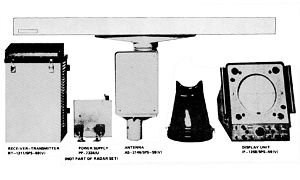LN-66
Description of the radar set, tactical-technical characteristics

Figure 1: LN-66

| Specifications | |
|---|---|
| frequency: | 9 375 MHz ( X-Band) |
| pulse repetition time (PRT): | |
| pulse repetition frequency (PRF): | 800, 1250, or 2500 Hz |
| pulsewidth (τ): | 0.5 or 0.9 µs |
| receive time: | |
| dead time: | |
| peak power: | 12 kW |
| average power: | 6.25 W |
| instrumented range: | 75 NM (≙ 139 km) |
| range resolution: | |
| accuracy: | |
| beamwidth: | 2.5° |
| hits per scan: | |
| antenna rotation: | 22, 24 or 30 rpm |
| MTBCF: | |
| MTTR: | |
LN-66
The LN-66, alias AN/SPS-59(V) was an X-Band surface surveillance and short-range navigation radar made by the Canadian Marconi Company. The radar was designed to detect surface obstacles or other vessels and utilizes a slotted linear waveguide array with a 4 ft (1.22 m) antenna. The radar was used aboard a wide range of surface combatants.
The radar was widely exported under various class names and designations:
- LN-66/HP for use in the Kaman Seasprite SH-2F LAMPS I helicopter. The antenna of this variant was mounted in a 3 ft enclosed radome.
- TPS-66 is a Canadian designation for the radar in the TSQ-108 Radar/Sonar Surveillance Center;
- The CMR-85 was designed for a submarine environment.
